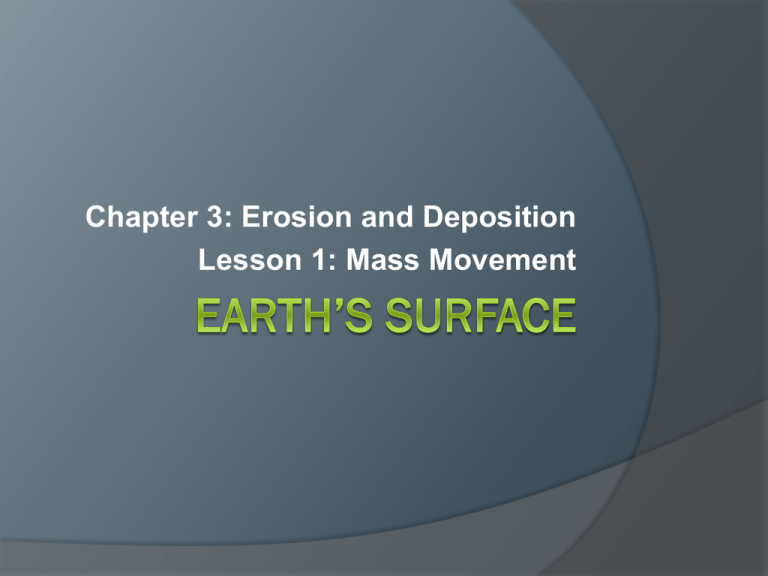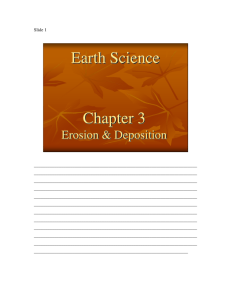Erosion
advertisement

Chapter 3: Erosion and Deposition Lesson 1: Mass Movement Erosion and Deposition Erosion: the process by which natural forces move weathered rock and soil from one place to another. Sediment: pieces of rock, soil, or remains of plants and animals. Deposition: when the agents of erosion deposit, or lay down, sediment. Erosion and Deposition Weathering, erosion, and deposition work together to wear down and build up Earth’s surface. What is Mass Movement? Mass movement is caused by gravity, and it causes sediment to move downhill (quickly or slowly). Landslides Mudflows Slumps Creep Types of Mass Movement Mudflow: the rapid downhill movement of a mixture of water, rock, and soil. Usually occur after heavy rainfalls in normally dry areas. Types of Mass Movement Landslides: when rock and soil slide quickly down a steep slope. Occurs most on unstable slopes (example: roads along highways). Types of Mass Movement Slump: a mass of rock and soil suddenly slips down a slope as one large mass. Occurs when water soaks the bottom of soil that is rich in clay. Types of Mass Movement Creep: very slow downhill movement of rock and soil. It is hard to visibly see creep happening, but you can see proof in tilted poles and trees in the ground. Chapter 3: Erosion and Deposition Lesson 2: Water Erosion Water and Erosion Moving water, called runoff, is the major agent of erosion that has shaped Earth’s surface. The amount of runoff depends on: Amount of rain Type of vegetation Type of soil Topography (shape of the land) Use of land Water and Erosion As gravity moves sediment downhill, changes occur on Earth’s surface. Rill: tiny grooves in the soil Gully: large groove (channel) that only hold water during rainstorms and usually dry up. Water and Erosion Water and Erosion Stream: channel along which water continuously flows downhill; rarely dries up. Large stream = river Tributary: a stream of river that flows into a larger river. Water and Erosion Rivers usually start as straight, narrow courses that are fast-flowing. They can create: Waterfalls Flood plains Meanders Oxbow lake Waterfalls Waterfalls occur when a river meets a block of hard rock. The river flows over this part, but then erodes the softer rock downstream. This eventually causes the waterfall. Flood plain A flood plain is a flat, wide area of land along a river. When the river floods, it covers this area and deposits sediment here. They have very fertile soil. Meanders A meander is a loop-like bend in the course of a river. as a river flows, it erodes the outer banks of the river and deposits sediment on the inner banks. Oxbow Lake An oxbow lake is a meander that has been cut off from the river. Water Deposition When moving water slows down, it drops (deposits) some of the sediment. Delta: sediment deposited where a river flows into an ocean or lake. Alluvial fan: wide, sloping deposit of sediment formed where a stream leaves a mountain range. Water Deposition Chapter 3: Erosion and Deposition Lesson 3: Glacial Erosion Glaciers Glacier: any large mass of ice that moves slowly over land. can form only in an area where more snow falls than melts. Continental Glaciers Continental glacier: a glacier that covers much of a continent or large island. Currently covers about 10% of Earth’s surface, and can flow in all directions as they move. During ice ages, these cover a much greater area of land. The most recent ice age caused the glacier to retreat about 10,000 years ago. Continental Glaciers Valley Glaciers Valley glacier: a long, narrow glacier that forms when snow and ice build up high in a mountain valley. Usually move downward on the mountains into valleys; generally moves slowly. Temperatures rarely rise above freezing, and the snow continues to build up. Valley Glaciers Glacial Erosion Plucking: glaciers pick up rocks as they flow over the land, and it moves the sediments (sometimes as large as boulders) across the land. Abrasion occurs between the rocks and the land, gouging and scratching the bedrock. Glacial Erosion Glacial Deposition Till: a mixture of sediments that a glacier deposits directly on the surface. The till deposited at the edge of a glacier forms a ridge, called a moraine. Kettle: small depression that forms when ice is left in a glacial till. When the ice melts, it leaves a “hole” which can then form with water as a pond or lake. Glacial Deposition Other Terms Fiord: when the sea rises, a valley fills with water. Horn: sharp mountain peak Cirque: bowl-shaped hollow eroded by glacier Arete: sharp ridge separating two cirques. Glacial lake: large lakes left by glaciers drumlin: long mound of till that is smoothed by the glacier’s flow. Other Terms Chapter 3: Erosion and Deposition Lesson 4: Wave Erosion Wave Erosion By impact: large waves hit rocks and break them apart. By abrasion: waves carrying particles hit the land and cause the rocks to break apart. Wave Erosion Headland: part of the shore that sticks out in the ocean; harder rock that resists erosion. Sea cave: formed when a hollow area is formed in a cliff on the shore. Wave cut cliff: when the rock below the cliff erodes and collapses. Wave Erosion Wave Erosion Sea arch: forms when waves erode a layer of softer rock that underlies a layer of harder rock. Sea stack: when an arch collapses, these pillars of rock remain. Wave Deposition Beach: area of wave-washed sediment along a coast. Longshore drift: waves usually hit the shore at an angle and travel parallel to the shore; sediments are deposited in this pattern. Wave Deposition Sandbar: long ridges of sand parallel to the shore. Barrier beach: forms when storm waves pile up sand above sea level, forming an island parallel to the coast (easily damaged by waves). Spit: beach that projects into the water; results from something interrupting longshore drift or a sharp turn in the coast. Wave Deposition Chapter 3: Erosion and Deposition Lesson 5: Wind Erosion Deflation Most common way for wind to cause erosion is deflation: when wind removes surface materials and transports them. Stronger winds can carry heavier sediments. Desert pavement: wind blows all of the sediments away, leaving only rocky material behind. Deflation Wind Deposition Sand dunes: deposit of wind blown sand; shape depends on direction of the wind, amount of sand, and presence of plants. They can be small or large They can move over time Plant roots help the dune from moving Sleeping Bear Dunes Wind Deposition Loess Deposits: when fine (silt and clay) sediments are carried and dropped in far away locations. Helpful in forming fertile soil for farming.






